Bigger braids are not necessarily better as the size of the braids depends on personal preference and styling goals. Are bigger braids better?
This question often comes up when deciding on a hairstyle. Many factors should be considered when determining the right size for your braids. While bigger braids can make a bold statement and create a voluminous look, they may also require more maintenance and take longer to install.
On the other hand, smaller braids offer more versatility in styling options and can be easier to manage. Ultimately, the choice between bigger and smaller braids depends on individual preferences, hair type, and desired outcome. So, rather than focusing on the idea of “bigger is better,” it’s essential to consider various factors to find the braids that best suit your personal style and needs.
The Size Factor: How Braids Impact Your Hairstyle
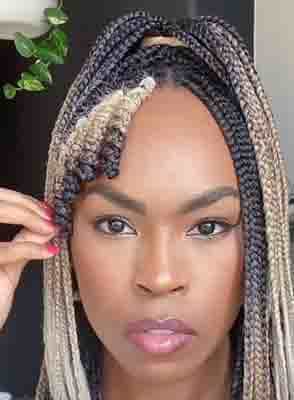
Bigger braids can have a significant impact on your hairstyle, adding volume and dimension. Their size can elevate your overall look, making a bold statement that is sure to turn heads.
Differentiating Between Big And Small Braids
- Big braids: Large sections of hair are used to create prominent, eye-catching braids. These braids are often thicker, offering a bold and statement-making look.
- Small braids: Delicate sections of hair are intricately woven to form smaller braids. These braids are typically thinner and can create a more intricate and detailed hairstyle.
Understanding The Visual Effects Of Bigger Braids
- Enhanced volume: Bigger braids can add volume and make your hair appear fuller, which can be particularly beneficial for those with fine or thin hair.
- Attention-grabbing style: Larger braids can be a focal point of your hairstyle, attracting attention and making a bold statement.
- Length illusion: Big braids can create the illusion of longer hair, especially when braided closer to the scalp.
Pros And Cons Of Bigger Braids Vs. Smaller Braids
Cons Of Bigger Braids

- Heavy feel: Larger braids can feel heavier on the head, especially when you have several of them. This may result in discomfort, particularly if you have sensitive or easily weighed-down hair.
- Limited durability: With bigger braids, there is a higher chance of them unraveling or getting messy sooner, especially if you’re active or frequently engaging in activities that may disturb the braids.
Pros Of Smaller Braids
- Intricate and detailed: Smaller braids can create more intricate and detailed patterns, adding a touch of elegance to your hairstyle.
- Longer-lasting: Due to the smaller sections and tighter braiding, smaller braids tend to have better durability and longevity.
- Lightweight and comfortable: Smaller braids are typically lighter and less burdensome on the scalp, allowing for greater comfort during wear.
Cons Of Smaller Braids
- Longer styling time: Creating smaller braids requires more time and patience, as the weaving process can be more intricate and time-consuming.
- Less voluminous look: Smaller braids may not offer as much volume or fullness compared to bigger braids. Those looking for a more voluminous hairstyle may prefer larger braids.
Factors To Consider When Deciding On Braid Size
1. Face shape and its influence on braid size
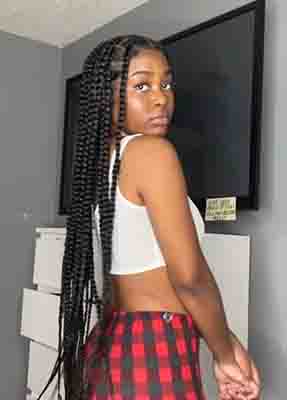
- Oval face shape: Versatility in braid size, as most sizes complement this shape.
- Round face shape: Opt for larger braids to create the illusion of length.
- Square face shape: Consider softer, smaller braids to add a touch of femininity.
- Heart-shaped face: Embrace various braid sizes but avoid extreme contrast.
- Diamond-shaped face: Choose braids that frame the face, such as delicate smaller braids.
2. Hair texture and thickness and their impact on braid size
- Fine hair: Smaller braids add texture and give the appearance of thicker hair.
- Thick hair: Larger braids provide a neat and proportionate look.
- Curly hair: Moderate to larger braids help showcase the natural curl pattern.
- Straight hair: Smaller braids create more definition and visual interest.
3. Lifestyle considerations when selecting braid size
- Active lifestyle: Choose smaller braids that are easier to maintain during physical activities.
- Low-maintenance preference: Opt for larger braids that require less frequent styling.
- Professional setting: Smaller, more polished braids can be a suitable choice.
- Personal style: Consider your fashion preferences and the overall look you wish to achieve.
Styling And Maintenance Of Bigger Braids
Discover the secrets to styling and maintaining bigger braids effortlessly. Embrace the versatility and statement-making potential of larger braids with expert tips and tricks.
In this section, we’ll explore some creative styling options, techniques for securing and maintaining your braids, as well as tips and tricks to make your bigger braids last longer.
Creative Styling Options For Bigger Braids
I. Half-up, half-down
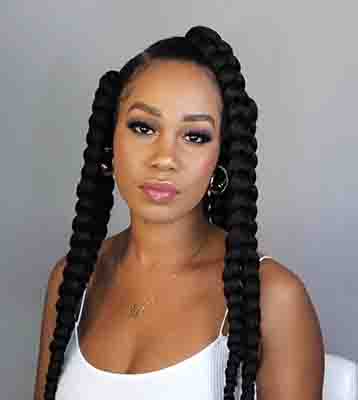
Create a chic and effortless look by leaving the top portion of your bigger braids loose while gathering the lower half into a ponytail or bun.
II. Braided crown
Transform your bigger braids into a regal hairstyle by wrapping them around your head like a crown. This elegant style is perfect for special occasions or when you want to make a statement.
III. Pigtails
Embrace a playful and youthful look by dividing your bigger braids into two sections and securing them with elastic bands. Pair this style with accessories like ribbons or beads for a fun twist.
IV. Braided updo
Elevate your bigger braids with an intricate and sophisticated updo. Twist and pin your braids into a bun or roll them up into an elegant chignon for a polished and timeless look.
Techniques For Securing And Maintaining Bigger Braids
- Tension and sectioning: To ensure a neat and secure result, start by sectioning your hair into small, even parts. Maintain consistent tension while braiding to prevent loose or uneven braids.
- Using hair products: Apply a small amount of edge control or hair gel along your hairline and partings to smooth and tame any flyaways. This will help your bigger braids stay in place and maintain a polished appearance.
- Securing with elastics: Secure the ends of your bigger braids tightly with small, transparent elastics to prevent them from unravelling or coming undone. Be gentle when removing them to avoid damaging your hair.
- Protective styling at night: Before going to bed, wrap your bigger braids with a satin scarf or sleep on a satin pillowcase. This will help minimize friction and prevent frizz or damage while you sleep.
Tips And Tricks For Managing And Extending The Lifespan Of Bigger Braids
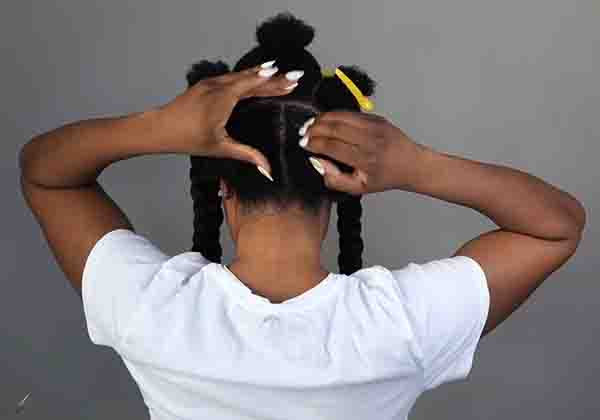
- Oiling the scalp: Keep your scalp moisturized by applying a lightweight hair oil or a mixture of natural oils to your scalp. This will help prevent dryness and itchiness, promoting a healthy environment for your braids.
- Avoid excessive manipulation: Minimize excessive touching, pulling, or styling of your bigger braids to prevent unnecessary stress and breakage. Give your hair regular breaks from styling to allow it to rest and recover.
- Regular cleansing: Cleanse your scalp and braids with a mild shampoo or a cleansing foam specifically designed for braids. Gently massage your scalp and rinse thoroughly to remove any buildup or residue.
- Trimming and re-braiding: Over time, your braids may start to loosen or lose their neat appearance. Consider trimming any frayed or damaged ends and re-braiding those sections to maintain a fresh and polished look.
Potential Risks And Precautions With Bigger Braids
1. Traction Alopecia: Avoiding Hair Loss
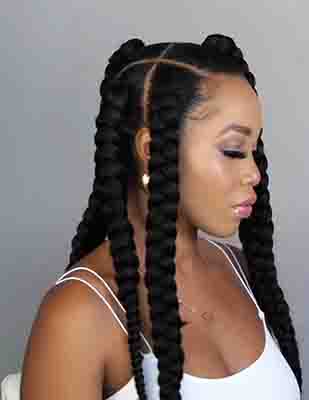
Traction alopecia can occur when braids are excessively tight or too heavy, leading to hair loss.
Prevent this condition by ensuring that your braids are comfortably snug and not overly tight. Avoid adding excessive weight to your hair.
2. Scalp Irritation: Maintaining Scalp Health
Larger braids may strain your scalp, potentially causing irritation or inflammation.
- Keep your scalp healthy by:
- Applying soothing natural oils (like coconut or jojoba) to your scalp before braiding.
- Refraining from excessive scratching or rubbing of the scalp.
- Using a gentle sulfate-free shampoo to cleanse both your scalp and braids.
3. Dandruff and Buildup: Avoiding Scalp Discomfort
Bigger braids can make it challenging to maintain a clean scalp, leading to dandruff and product buildup.
- Prevent these issues with:
- A diluted apple cider vinegar rinse to break down product buildup on the scalp.
- A gentle scalp exfoliator to remove dead skin cells and prevent dandruff.
- Regularly hydrating your scalp with a lightweight moisturizer or oil.
4. Hair Breakage: Protecting Hair Strands
The tension applied during braiding can weaken hair strands, leading to breakage.
- Safeguard your hair by:
- Choosing a professional braider who understands the importance of proper tension.
- Avoiding excessively tight braids or pulling on the hair.
- Selecting a braid size that balances thickness with your hair’s strength.
Celebrities And Their Take On Bigger Braids
Celebrities have been embracing bigger braids, with some arguing that they offer a more striking and fashionable look. These larger braids have gained attention for their versatility and ability to make a statement.
Iconic Celebrity Hairstyles Featuring Bigger Braids
Braids have long been a popular hairstyle choice, but it’s the bigger braids that have captured the attention of both celebrities and the general public. These iconic celebrity hairstyles featuring bigger braids have made a significant impact on fashion trends and inspired countless individuals to rock this bold and fashionable look.
- Solange Knowles: The Grammy-winning singer is known for her fearless style, and her iconic big braids have become a signature look. With her intricate and voluminous braided hairstyles, Solange consistently sets new standards for bold braided fashion.
- Beyoncé: Queen Bey has sported various bigger braid hairstyles throughout her career, often opting for long, chunky braids that add dimension and visual interest to her overall look. Her braided hairstyles have become a symbol of power, femininity, and cultural pride.
- Kendall Jenner: While Kendall Jenner is known for her sleek and chic aesthetic, she’s also been spotted flaunting bigger braided styles. Whether it’s in a high ponytail or cascading over her shoulder, Jenner effortlessly blends high fashion with this trendy hairstyle.
- Zoe Kravitz: With her distinctive sense of style, it’s no surprise that Zoe Kravitz often rocks bigger braids. From classic box braids to intricate cornrow styles, Kravitz’s braided looks exude confidence and individuality.
- Alicia Keys: The talented singer-songwriter has always been a trailblazer, and her choice of bigger braided hairstyles complements her free-spirited persona. Keys often wears her braids in creative updos or flowing cascades, effortlessly showcasing the versatility of this hairstyle.
Influential Individuals Promoting Bigger Braids As A Fashionable Choice
- Beyond the realm of celebrities, there are influential individuals who have embraced bigger braids and promoted them as a fashionable choice. These individuals have showcased the beauty and versatility of bigger braids, inspiring others to try out this bold hairstyle.
- Lizzo: The Grammy-winning artist consistently uses her platform to encourage self-love and confidence, and her experimentation with bigger braided styles is a testament to her commitment to embracing one’s unique beauty. Lizzo’s bigger braids exude strength and empowerment.
- Lupita Nyong’o: Renowned for her stunning red carpet appearances, Lupita Nyong’o has become a style icon in her own right. She has embraced bigger braids on numerous occasions, transcending traditional beauty standards and proving that big braids can be glamorous and sophisticated.
- Rihanna: Known for her fearless fashion choices, Rihanna has been a vocal advocate for embracing individuality. Her occasional donning of bigger braids showcases their versatility and the endless possibilities to create distinctive and head-turning looks.
- Janelle Monáe: With her eclectic style and boundary-pushing fashion choices, Janelle Monáe consistently promotes the idea of expressing oneself through personal style. Her bigger braided hairstyles often feature unique patterns and vibrant colors, capturing attention and inspiring others to experiment with their own hair.
Social Media Trends And Popular Cultural References
Bigger braids have also seen a surge in popularity thanks to social media trends and popular cultural references. Whether it’s through viral videos or influential personalities, these platforms have played a significant role in bringing bigger braids to the forefront of fashion.
TikTok
As one of the most influential social media platforms today, TikTok has become a hub for beauty and fashion trends. Users have embraced bigger braids, with countless tutorials, styling tips, and challenges showcasing different ways to rock this hairstyle.
Black Panther
The 2018 blockbuster film broke barriers and celebrated African culture, including its diverse hairstyles. The movie’s portrayal of powerful women like Okoye, played by Danai Gurira, with stunning bigger braids, was not only visually captivating but also sparked a renewed love for this traditional African hairstyle.
Music Videos
Numerous music videos of popular artists feature bigger braids, contributing to their mainstream popularity. Notable examples include artists like Cardi B, Megan Thee Stallion, and WizKid, who showcase bigger braids in their music videos, making them a trendy and fashionable choice.
Street Style Influencers
Street style influencers have also played a role in popularizing bigger braids. Their unique and authentic looks, often captured in candid street shots, have helped showcase the versatility and appeal of bigger braids to a wider audience.
African Cultural Influences
The celebration of African culture and heritage has been a prominent theme in recent years. This renewed interest has brought bigger braids back into the spotlight, with individuals embracing this traditional African hairstyle with pride and incorporating it into their everyday fashion choices.
Bigger braids have become more than just a hairstyle. They represent individuality, cultural pride, and a fashion-forward mindset. From iconic celebrity hairstyles to influential individuals promoting this bold choice, and the impact of social media trends and popular cultural references, it’s clear that bigger braids are a fashion statement worth embracing.
Bigger Braids Step-By-Step Tutorial
Discover a step-by-step tutorial on achieving bigger braids effortlessly. Explore whether bigger braids are truly better for your hair.
A Detailed Guide On How To Achieve Bigger Braids
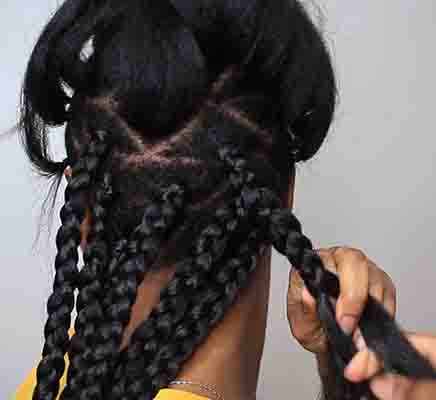
If you’re looking to try out a new hairstyle that adds volume and flair to your look, bigger braids might be the perfect choice for you. Not only are they a trendy and stylish option, but they can also be quite easy to create with a little know-how.
In this step-by-step tutorial, we’ll guide you through the process of achieving bigger braids that are sure to turn heads.
Prepare your hair
- Start with clean, dry hair: It’s best to wash and thoroughly dry your hair before starting the braiding process to ensure a neat and long-lasting result.
- Add some texture: If your hair is too slippery or smooth, consider adding some texture by applying a texturizing spray or dry shampoo to provide more grip for the braids.
Section your hair
- Divide your hair evenly: Use a comb to create a clean part down the middle of your head, dividing your hair into two equal sections. You can secure one section with a hair tie to keep it out of the way while you work on the other side.
- Create smaller sections: Take small sections of hair from the unsecured side and separate them into three equal parts. Hold each part firmly between your fingers to keep the braid tight and secure.
Start braiding
- Cross the sections: Take the right section of hair and cross it over the middle section, then take the left section and cross it over the new middle section. Repeat this crossing motion, alternating sides, until you’ve reached the desired length of the braid.
- Maintain tension: Make sure to keep a consistent tension on each section of hair as you braid to ensure an even and uniform look.
Secure the ends
- Use a small hair tie: Once you’ve reached the end of the braid, secure it with a small hair tie to keep it in place. You can also use a clear elastic band for a more seamless finish.
- Optional: Gently tug at the sides of the braid to loosen it and create a fuller, more voluminous appearance.
Necessary Hair Products And Tools For Successful Braiding:
To achieve the best results when creating bigger braids, it’s important to have the right hair products and tools on hand. Here are a few essentials to consider:
- Hairbrush or comb: Use a wide-toothed comb or a paddle brush to detangle your hair and ensure a smooth braiding process.
- Hair elastics: Have a stash of small hair elastics or clear elastic bands to secure the ends of your braids and keep them in place.
- Texturizing spray or dry shampoo: These products can add grip and texture to your hair, making it easier to braid and helping the style last longer.
- Bobby pins: Keep a few bobby pins handy to secure any loose strands or flyaways that may pop up during the braiding process.
- Hairspray: Finish off your braided style with a light mist of hairspray to provide hold and reduce frizz.
Tips For Beginners And Troubleshooting Common Issues
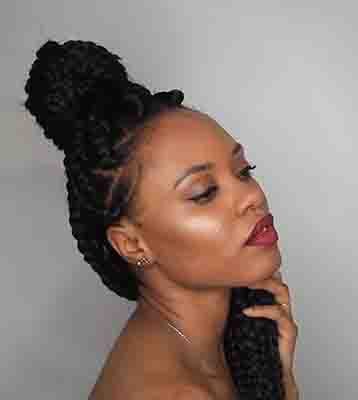
Braiding can be a bit challenging, especially for beginners. But with these helpful tips and troubleshooting suggestions, you’ll be able to overcome common issues and achieve beautiful bigger braids:
- Start with smaller braids: If you’re new to braiding or finding it difficult to manage larger sections of hair, start by practicing with smaller braids until you feel more comfortable and confident.
- Work with damp hair: Braiding slightly damp hair can make it easier to grip and manipulate, especially if you have fine or slippery hair.
- Use hair extensions: If you have thin or short hair and want to create bigger braids, consider using clip-in hair extensions for added length and volume.
- Keep your hands clean: Oily or sweaty hands can make it harder to grip the hair, so make sure your hands are clean and dry before you start braiding.
- Take breaks if needed: If your arms or hands start to feel tired or cramped, take short breaks during the braiding process to avoid straining your muscles.
- Experiment with different techniques: Don’t be afraid to try out different braiding techniques, such as Dutch braids or fishtail braids, to add variety and interest to your bigger braids.
Remember, practice makes perfect, so give yourself some time to learn and master the art of bigger braids. With the right technique, tools, and a little bit of creativity, you’ll be rocking stunning braided hairstyles in no time.
FAQ
The choice between small or large box braids depends on personal preference and hair type. Smaller braids can last longer, while larger ones are quicker to install.
Excessively tight braids can cause tension on the scalp, potentially leading to hair breakage or hair loss. Proper tension is essential for healthy hair.
Smaller braids distribute tension more evenly, which can be gentler on your hair. They are a good option for those looking to protect their hair.
Tight braids can last longer and may give a neater appearance, but it’s crucial to avoid excessive tension to prevent damage.
Braids that are installed with proper tension and not excessively tight should not hurt. Pain is a sign of too much tension.
Braids should be comfortably snug but not excessively tight. They should not cause pain or discomfort.
Tight braids can be healthy if installed correctly with the right tension. Excessive tightness can lead to damage.
Choosing between small or medium box braids depends on your preference and desired style. Medium braids are a popular choice for versatility.
Generally, small braids can last longer than larger ones due to their size and complexity.
Smaller braids are often better for fine hair because they distribute the weight more evenly and reduce the risk of breakage.
Box braids tend to last longer than knotless braids due to their structure and size, but both styles can be long-lasting with proper care.
Small braids can cause breakage if installed too tightly or if not properly maintained. It’s essential to strike a balance.
Jumbo braids are a stylish and quicker option, but they may not last as long as smaller ones. The choice depends on your preferences.
Jumbo braids can protect your hair, reducing breakage, which may promote the appearance of healthier and longer hair.
Jumbo box braids can potentially damage hair if not installed and maintained correctly. Proper care is essential.
Thick braids can last several weeks to a couple of months, depending on factors like care and hair type.
Braids may feel slightly less tight over time as your hair naturally settles into the style, but they should not become uncomfortably loose.
Conclusion
While the debate continues on whether bigger braids are better, it ultimately comes down to personal preference and individual hair type. The advantages of bigger braids include reduced styling time, less tension on the scalp, and the ability to showcase intricate patterns and designs.
On the other hand, smaller braids offer greater versatility and longer-lasting results. It’s important to consider your hair’s length, thickness, and desired outcome when choosing between big and small braids. Additionally, proper maintenance and care are essential to ensure the longevity and health of your braided hairstyle, regardless of the size.
Remember to moisturize, protect your edges, and avoid excessive tension or pulling. Ultimately, the key is to find a braid size that complements your style, enhances your natural beauty, and makes you feel confident and comfortable. Happy braiding!

